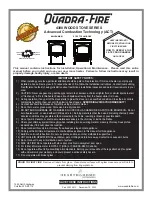
14
coal and the furnace reacts together. Adjusts draft s accordingly.
Loading with a good bed of coals in the morning - Open by-pass
damper.
In normal shaking, only rock the grates a small amount to sift
ash through. Do not agitate the fi re bed too oft en. Th
is practice
will waste coal. If glowing coal is visible in the ash pan, you have
shaken to much.
Remove all ashes every day from ash pit.
CAUTION: Ashes should be placed in a steel/metal container
with a tight fi tting lid. Th
e closed container of ashes should be
placed on a non-combustible fl oor or on the ground well away
from all combustible materials pending fi nal disposal. If the
ashes are disposed of by burial in soil or otherwise locally dis-
persed, they should be retained in the closed container until all
coals have thoroughly cooled. Do not place other waste inside
this container.
With your poker, push hot burning embers to the rear of the unit
and add green coal in front. NEVER load over height of fi rebrick.
Th
is can result in damage to your furnace and home.
Close by-pass damper.
Too much draft air will cause clinkering of coal and will waste
heat up the chimney. Shut draft down to as low a point as you can
and still heat your home.
NOTE: Never stand in front of loading door when opening it.
Stand to the side.
NEVER completely cover the live fi re with fresh coal. Always
leave a generous area of glowing coal at the top of the fi re and
at the rear.
Always keep the ash pit clean.
If the fi re goes out or does not hold overnight, look for:
Poor draft .
Incorrect damper settings.
Improper fi ring methods for coal being used.
More combustion air needed.
Coal not sized to the furnace. We recommend 1” to 3” diameter
pieces of coal.
Ashes, if allowed to accumulate in the ash pit, will not allow the
passage of required air for combustion. Keep ash pit clean.
Th
is furnace is not to be used with an automatic stoker unless
so certifi ed.
POWER OUTAGE OPERATION
U. S. Stove strongly suggest using a back-up generator to oper-
ate your furnace during a power outage situation. However, your
furnace may be operated without power for a short period of
time assuming your installation allows such operation. Please
review and follow these instructions.
Remove any and all air fi lters throughout the air ducting system
to increase the movement of air.
Reduce the combustion air intake to a minimum in order to slow
the burn rate of the appliance.
If the Draft Blower is installed, close it’s damper so that no more
than 1/4 of the total inlet area is open.
If you installation incorporates a bypass damper in the duct
work, the damper must be opened to allow heat to escape the
fi rebox so as not to damage any electrical components.
If the bypass damper is one that is designed to fall closed when
the blowers are not running and there is no way to open the pas-
sage, you will need to shut-off all combustion air to the appli-
ance.
Observe the furnace operation closely and oft en until power is
restored.
CAUTION: To avoid excessive temperatures, do not operate
with fuel door or ash pan open.
VISIBLE SMOKE
Th
e amount of visible smoke being produced can be an eff ective
method of determining how effi
ciently the combustion process
is taking place at the given settings. Visible smoke consist of un-
burned fuel and moisture leaving your stove. Learn to adjust the
air settings of your specifi c unit to produce the smallest amount
of visible smoke. Wood that has not been seasoned properly and
has a high wood moisture content will produce excess visible
smoke and burn poorly.
EFFICIENCY
Effi
ciencies can be based on either the lower heating value (LHV)
or the higher heating value (HHV) of the fuel. Th
e lower heating
value is when water leaves the combustion process as a vapor, in
the case of woodstoves the moisture in the wood being burned
leaves the stove as a vapor. Th
e higher heating value is when wa-
ter leaves the combustion process completely condensed. In the
case of woodstoves this would assume the exhaust gases are room
temperature when leaving the system, and therefore calculations
using this heating value consider the heat going up the chimney
as lost energy. Th
erefore, effi
ciency calculated using the lower
heating value of wood will be higher than effi
ciency calculated
using the higher heating value. In the United States all wood-
stove effi
ciencies should be calculated using the higher heating
value. Th
e best way to achieve optimum effi
ciencies is to learn
the burn characteristic of you appliance and burn well-seasoned
wood. Higher burn rates are not always the best heating burn
rates; aft er a good fi re is established a lower burn rate may be a
better option for effi
cient heating. A lower burn rate slows the
fl ow of usable heat out of the home through the chimney, and it
also consumes less wood.
OPERATIONAL TIPS
Operational Tips for Good, Effi
cient, and Clean Combustion
Get the appliance hot and establish a good coal bed before ad-
justing to a low burn rate (this may take 30 minutes or more
depending on your wood)
Use smaller pieces of wood during start-up and a high burn rate
to increase the stove temperature
Be considerate of the environment and only burn dry wood
Burn small, intense fi res instead of large, slow burning fi res when
possible
Learn your appliance’s operating characteristics to obtain opti-
mum performance
Burning unseasoned wet wood only hurts your stoves effi
ciency
and leads to accelerated creosote buildup in your chimney







































